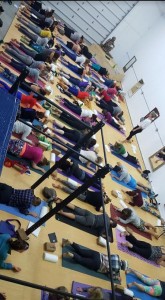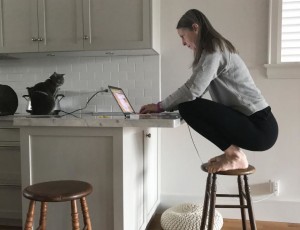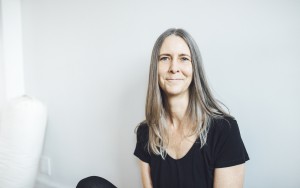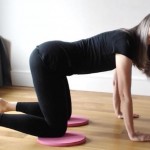Falling In Love with Movement (again)
By Carol Robbins
June 20, 2018
Even though I had 18 years of Pilates under my belt before I waved goodbye to a reformer, I’m still surprised when Brett requests another article. I was a student of Pilates for several years before I trained as a teacher (first with Stott, then Dianne Miller, mentoring for many years with Eileen Birks). I taught full time for most of those years. I have a confession; I was enamored with the equipment part of Pilates, but I really didn’t like teaching mat classes! I was encouraged by my certifying school to teach at least some mat work for every session, even if the client was paying for an equipment class, which I never really understood – equipment is expensive, and anybody can lie on the floor at home. I found mat boring … and equipment fun.
So, it’s kind of crazy to think I gave up equipment altogether (other than the occasional half dome and yoga block or bolster … or tree) and am still constantly challenged. My classes are inventive and I can even surprise myself sometimes with the direction they take (not at all rote as Pilates can sometimes be). So, what is the difference? What does my current movement practice look like and why is it so different that 6 years after switching to Restorative Exercise (which looks so simple from the outside), I’m still excited to get on the mat each day?
When you are teaching exercises (in the context of strengthening or improvement), you are still teaching the ability to do that exercise. Rollup or rolldown is supposed to teach sequential spinal articulation and strength. What is the ability to articulate each vertebra relative to the one above and below it necessary for, other than doing a roll down? And how strong is strong enough? Is the ability to increase strength finite or infinite? When you get someone to hang onto a bar so they can slow the rolldown and you can coach them through “stuck” areas and decrease the load (outsourcing it to the spring) while asking for more endurance, what is that for?
I think if you can answer those questions, you can remain happy in your work. I got to the point where I could not. (And I’m not suggesting that you can’t, it all comes down to what your objective is; there are legitimate reasons for learning and teaching Pilates.)
 One of the things I love about RE is that it taught me to consider the load profile and to make as objective of an assessment as I can. But most of all, the exercises are done out of context so that we can see what is missing from our movements done in context. For example, a calf stretch might be an application of a tensile load to the posterior lower leg, but if that results in various compensations, we can safely assume that a deficiency in dorsiflexion is going to have a deleterious effect on knees, hips, pelvic floor, lower back, etc. (depending on the compensation) in that person’s gait. Many of the RE exercises are gait related, as we believe that it is the touchstone of all human movement and is not replaced by Pilates or swimming or anything else. No amount of exercise can replace the 3 to 10 miles of daily walking you should be doing; humans require it for optimal biological function. You can’t replace the 10,000 times you’d extend your hips and swing your arms during a 5-mile walk with an hour in the studio.
One of the things I love about RE is that it taught me to consider the load profile and to make as objective of an assessment as I can. But most of all, the exercises are done out of context so that we can see what is missing from our movements done in context. For example, a calf stretch might be an application of a tensile load to the posterior lower leg, but if that results in various compensations, we can safely assume that a deficiency in dorsiflexion is going to have a deleterious effect on knees, hips, pelvic floor, lower back, etc. (depending on the compensation) in that person’s gait. Many of the RE exercises are gait related, as we believe that it is the touchstone of all human movement and is not replaced by Pilates or swimming or anything else. No amount of exercise can replace the 3 to 10 miles of daily walking you should be doing; humans require it for optimal biological function. You can’t replace the 10,000 times you’d extend your hips and swing your arms during a 5-mile walk with an hour in the studio.
By virtue of increasing dorsiflexion, we can assume that the compensations will decrease, and that person can access full knee and hip extension (for example) and then, when they walk, they are decreasing the extra loads their knees were experiencing and toning their backsides to support the sacrum in nutation, giving the pelvic floor a much-needed boost. The client doesn’t need to think “navel to spine” or “tail under” or “chest up” or anything else for that matter – because walking is not an exercise and the body parts you bring to it will determine the outcome. Coaxing those body parts to come to the party is my job, or at least finding them. The client must be responsible to move enough to use them (and thus, most of their work continues outside of studio time).
If your knees hurt too much to walk, you could do your leg and footwork on a reformer where your knees don’t need to support your body weight, and you can maintain movement in the joints (benefit!). But that might not cross over to the context of walking where they do have to carry your body weight (principle of specificity).
What I do doesn’t look like a classic strength/stretch class and yet my clients groan with effort and are constantly amazed at how challenging moving can be (or occasionally delighted at how easy it is). They report small but significant changes every day. It inspires them to live in a way that requires more movement and work towards abilities they never thought they had, such as climbing a tree, walking along a fallen log … walking 20 miles in one day.
Subsequently, I have found the benefits of moving off a machine and rediscovered the joy of the floor (which as it turns out, is quite an advanced piece of equipment!). RE levels the playing field because we’re all participants in our culture and suffer the consequences of modern life; I’m only the guide to a client’s progress and not the “expert” in terms of being able to do exercises perfectly or at the most advanced level. Similarly, no one is a beginner in terms of being a moving human (unless you were just born). There are no “levels” of ability, just boundaries to recognize and parameters to maintain (in order to meet the objectives of the exercise).
This makes the work of teaching a dynamic art (which is the human body in gravity) endless. Is the objective of teaching beginner Pilates the ability to advance to harder exercises? Once you perfect the art of Advanced Pilates, what do you do? Do you just run through the advanced exercises? That would be like taking a Grand Prix horse through a Grand Prix test every day (or once a week). Is it just maintenance at that point? Is the body pain free, disease free? To me, Pilates is like an athletic pursuit (nothing wrong with that) and RE is like the manual on how to use your body. It’s just a more compelling reason (to me) to motivate movement. Just like taking a run through the forest is not the same thing as connecting with nature, doing Pilates is not a replacement for a holistic movement practice.
 Rather than limit my movement practice to a studio setting in a specific time frame, my movement practice takes place 24 hours a day and includes things like swallowing, eyesight, digestion, bone formation, temperature tolerance, skin robusticity, pressure to body parts (good and bad), biological requirements, human interaction, adaptation, invisible anatomy (forces) and too many more to mention. It changes the cells in the brain more than (but slower than) the cells in my body.
Rather than limit my movement practice to a studio setting in a specific time frame, my movement practice takes place 24 hours a day and includes things like swallowing, eyesight, digestion, bone formation, temperature tolerance, skin robusticity, pressure to body parts (good and bad), biological requirements, human interaction, adaptation, invisible anatomy (forces) and too many more to mention. It changes the cells in the brain more than (but slower than) the cells in my body.
I have fallen in love with movement again.

She blogs at alignmentrescue.com and can be found on Vimeo, Facebook and Instagram.

